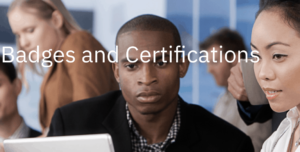On Merit Badges

What is a Merit Badge? Like the Scouts, a merit badge is an award for demonstrated mastery of a skill. Scouts have used badges for 100 years to motivate and recognize youth development. Badges have become popular as a reward mechanism in casual games and social networks like foursquare.com.
How could badges be used in education?
Like a gold star, a badge could be awarded for successful completion of any planned activity or for adhering to a code of conduct over a period of time. For this discussion, let’s define a merit badge as awarded competence for a skill or a unit of study with clearly define goals.
Why do Merit Badges make sense in education?
If we assume there would be about 500 K-12 merit badges (i.e., about one eighth of the number of individual standards, but about 8 times the number of courses or subject-years), badges are
- Right sized: bigger than a lesson on a subskill and smaller than a course on a subject, a unit that takes about 1-3 weeks to complete is just right to guide personalized progress.
- Motivational: badge accumulation will increase persistence and time on task.
- Flexible: units of study can be constructed using a variety of strategies that leverage community assets, industry clusters, and interests.
- Competency-based: students can take as much or as little time on particular units as necessary. Multiple assessments will certify mastery.
- Personalized: student will have some ability to choose the badges they work on and, within each badge, can customize their learning and how they demonstrate mastery.
Badge Design
A well constructed badge sequence would result in student clarity about what is expected and how they would demonstrate learning, “What do I need to learn, and how do I show what I know?” Individual badges will have:
- Clear goals that incorporate one or more Common Core standards
- Multiple forms of assessment including where possible an adaptive assessment (e.g., a game or sim), a benchmark assessment (e.g., an end of unit quiz), a performance assessment (e.g., an essay and presentation)
- Required elements and choice of elements (i.e., one of three options: project, experiment, tasks, or assignments)
- Multiple instructional resources including where possible text with voice over (e.g., Hippocampus), learning games (e.g., MangaHigh, Gamestar Mechanic), simulations (e.g., Phet) and virtual environments (e.g., MuzzyLane), ttutorials (e.g., Khan Academy), videos (e.g., Brightstorm, iTunes U)
Like any curriculum, design principles would guide badge development. For example, a set of design principles may require that students:
- write and wrestle with challenging text every day
- struggle with complex problems every week
- develop and defend a point of view
- form the financial literacy to build a sustainable life
- collaborate to produce quality work products on a timeline
- know enough about their world to form an informed perspective
- experience beauty and wonder in nature and in the act of creation
- spend time with adults they can imagine themselves becoming
- own expectations and make regular demonstrations of their learning
- experience success in what’s next: college, career, community service
Individual badges could be combined in to challenges (or super-badges) that are larger, longer, integrated thematic units of study.
What’s the right unit of study?
For 115 years, secondary education in the US has been organized around Carnegie Units, 120 contact hour with an instructor, which standardized transcripts for the benefit of college admissions process. For decades, states have defined graduation requirements in terms of credit hours by subject. For example, New York state requires 22 credits to graduate including four years of English and three years of math.
For more than a century, schools have grouped students by age group and have produced a normal distribution of academic results highly correlated with social status. For a century, textbooks have been produced to support a credit hour of study.
Historically, failure was treated by repeating a grade and more recently by social promotion—neither satisfactorily preparing a high percentage of students for college and careers. Recent interest in competency-based learning and dropout prevention has yielded schools that blend online and onsite learning to better personalize instruction—they make time the variable and learning the constant.
In the early 1990s nearly every state implemented academic standards. After 2001, the federal government required, for receipt of education funding, that every state have standards and test against those standards in grades three to eight. Each state defined thousands of discrete items that students should know and be able to do (e.g., Washington State has about 4100 learning expectations).
More than 40 states have adopted Common Core Standards—an attempt to create expectations that are fewer, clearer, and higher than most state standards—and there is high interest in tagging digital content to Core standards. The new standards were developed around knowledge and skills not courses making this a perfect time to reconsider the basic building blocks of education.
Digital learning makes it possible to imagine a customized learning experience for every student. The possibility begs the question, how should we organize learning? Should it be organized around and reported by the thousands of subskills? Most new electronic gradebooks facilitate reporting of student progress to the standard level. But working through a checklist of 4,000 discrete standards is hardly motivating even if there are a variety of possible learning strategies.
International commerce was revolutionized by asking what’s the right shipping container? The shift from print to digital is resulting in an explosion of content that will be tagged as objects, lessons, units, courses, and multi-grade sequences. School of One introduced the idea of a playlist as a customized learning sequence. It’s the right time to reconsider courses as the building block of secondary education. Lessons are too small, courses are too big, units of study are just right to facilitate personal digital learning.
What’s an example of a merit badge?
New Jersey has 12 categories of math standards, one is Number Sense. One of the 15 standards in grade 5 is Develop and use order relations for integers and rational numbers. Here’s an example of a subskill a 5th grader should possess and a question they should be able to answer:
Students gain understanding of the order relationships among fractions and integers by comparing them with similar ones for whole numbers.
How is the comparison of 4/7 to 5/7 like the comparison of 4 to 5? How is comparing 4/7 to 4/8 like comparing 7 to 8? How is comparing -4 to -7 like comparing 4 to 7?
This skill could be incorporated into merit badge on Parts that also investigated ratios, proportions, and percents. Instructional materials would include lessons, MangaHigh’s Flower Power, and videos. Students would be requires to apply their knowledge and could choose between a sports, music, and current events activities. All students would be required to write a short set of instructions demonstrating command of ratios and order relations.
The Parts badge could be combined with a social studies badge and a science badge to create a larger six week thematic challenge for a groups of four students. Teachers could create challenges and students can suggest challenges as part of an individual learning plan.
How would teacher students access badges?
Merit Badge folders will carry a Creative Commons license and will be available on the OER Learning publisher page on a social learning library like Edmodo. Schools could gain access to an entire secondary curriculum for free but may want to purchase assessment services and implementation support.
Some schools/teachers will choose a few units of study or a course sequence like Algebra 1, Geometry, and Algebra 2. Other schools will adopt the entire curriculum and a blended performance-based school model.
Teachers could provide access to as many badges as they thought was productive to groups of students. Some schools may assign one or two units at a time, others would provide access to the full library of units and allow students more flexibility in the units that students attempt.
How would teachers track student progress?
Students and advisors will set goals for badge accumulation. A standards-based gradebook will be modified to track progress against standards well we as badges earned. Badges will be converted into courses for a transcript purposes (to support college admissions).
How will merit badge schools operate?
The curriculum will be ideal for blended secondary schools. It will facilitate a significant about of individual autonomous work. Some badges will require collaborative effort; the total amount of collaboration will vary depending on how productive it is as a learning strategy for individual students.
Adaptive assessments and transcripts will be used to place students in the badge sequence. Badges will be translated into courses for transcript purposes.
Badges will not require whole group instruction, but some schools may want to incorporate seminars around constructed challenges. Students may be required to take end of course assessments or end of year assessments; schools may want to incorporate test-prep activities.
As noted in March, “the Common Core creates a great opportunity to revise state standards and assessments. By defining competency clusters and related groups of assessments, ‘merit badges’ could replace courses, credits and seat time matriculation.” Merit badges could boost motivation, personalize learning, and improve operating efficiency.







0 Comments
Leave a Comment
Your email address will not be published. All fields are required.